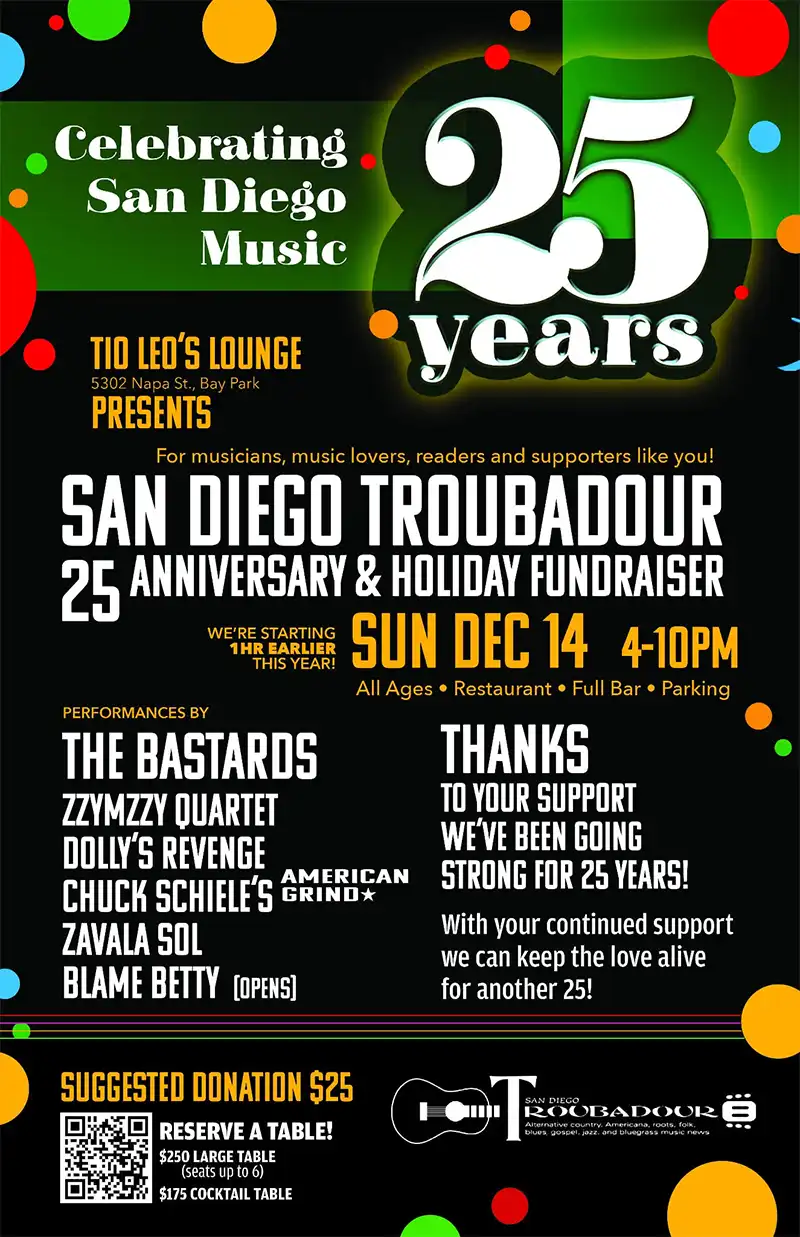Recordially, Lou Curtiss
Things I’m Doing
My radio show (JAZZ ROOTS, KSDS 88.3 FM, Sunday nights from 8 pm to 10pm) will go into repeat mode for the month of November and probably December. According to the station the reason is logistical problems. I’m certainly willing to continue putting out newly recorded shows and have some jim dandy new old-time stuff to share with you all as soon as they give me the go ahead. I’m coming up on my 30th year of sharing Sunday nights with all of you and I’d like to continue doing it as long as I can. I’m thinking about doing some “Jazz Roots Record Parties” to tide things over. Any one have any ideas? Let me know.
You can always get some fine old-timey 78 tracks and related types of music I’m interested in if you check out my Facebook page (that’s Louis F Curtiss). I’ll also try to keep you informed about things old and new that come along and relate to the kinds of music I’m interested in.
I’m still working on digitizing the tapes from the 56 music festivals I’ve had the good fortune to put together (including the 20 San Diego State Folk Festivals, all those Adams Ave Roots Festivals, and 15 or so Adams Ave. Street Fairs) plus a lot of other stuff. The digital recordings are going to the collections at the Library of Congress, the UCLA Ethnomusicology Collection, and the Library at San Diego State University. I’m also passing along a thing or two via my Facebook page. And now, on to some old record stuff.
Eddie Lang and Lonnie Johnson: Two Great Guitars Together
It was a bit of inspired genius on the part of Tommy Rockwell, who was the A&R man for Okeh Records in the late 1920s, to bring together in a recording studio the two greatest guitarists on the jazz scene at that time, namely EDDIE LANG and LONNIE JOHNSON.
Their respective backgrounds couldn’t have been more different. Lonnie Johnson, born in New Orleans at the turn of the century, lost most of his relatives to the great influenza epidemic in 1922. He earned a living with his music, traveling the breadth of this country from the 1920s into the 1960s, winning the respect and admiration of generations of blues and jazz enthusiasts the world over.
Eddie Lang, born Salvatore Massaro in Philadelphia, in 1903, trained in the European cultural traditions and died a few months before his 30th birthday, following a tonsillectomy on March 26, 1933. He was a classically trained, self-avowed worshipper at the feet of Andres Segovia — a sophisticated white musician able to accompany any kind of singer, from intimate cabaret artists like Annette Hanshaw to extroverted blues shouters like Bessie Smith.
In only ten years Lang packed almost as much music on wax as Lonnie Johnson did in four times as many years of recording activity.
Lonnie Johnson’s most famous recordings are those under his own name as a self-accompanied blues singer-guitarist, as a soloist, and in duets with Eddie Lang. Eddie Lang, however, was a regular member of many top dance bands in the ’20s (such names as Paul Whiteman, Charles Kerr, Roger Wolfe Kahn, Freddie Rich, and Adrian Rollini’s New Yorkers come immediately to mind), and he recorded with every kind of group, from Red MacKenzie’s Mound City Blue Blowers to Frank Ferera’s Hawaiian Trio. Eddie Lang was especially known for his longtime association with jazz violinist Joe Venuti.
It seems likely that Lang and Johnson met when Lonnie Johnson came to New York during the summer or early autumn of 1928. The duets, issued on the Okeh race label, with Lang using the pseudonym of Blind Willie Dunn, a name, it was rumored, that Lang got from a blind newsboy from whom he bought his evening paper, were successful enough for a second session of duets to be recorded in 1929.
His background not withstanding, Eddie Lang was able to adapt his playing to the requirements of the blues style on Lonnie Johnson with exquisite, even awe-inspiring, results. Few, if any, of his eastern fellow musicians could, with one exception being Frank Signorelli, who often accompanied Lang on piano and easily the hero of a thousand sessions with every conceivable kind of artist, as was Eddie Lang himself.
The third session that brought the two guitarists together occurred on April 30, 1929 and has to be one of the stranger sessions in jazz history. Issued as “Blind Willie Dunn’s Gin Bottle Four,” the two selections, “Jet Black Blues” and “Blue Blood Blues,” also featured pianist and composer J.C. Johnson (who is better known as the author of such commercial dance band hits as “Louisiana,” “Dusky Stevedore,” and “When,” all made famous by the great Bix Beiderbecke). The curious clinking and clunking sounds are produced by another famous composer, Hoagy Carmichael, who also contributed a scat vocal on each number.
The cornet player is no less a celebrity than Joe “King” Oliver, who was, at that time, down on his luck in New York, without a regular band and subsisting on royalties from past successes. Oliver was suffering such pain from his teeth that he could hardly play his cornet. However, there is some majestic cornet work here, especially on “Blue Blood Blues,” with its sustained high notes over the rippling effect from Lonnie and Eddie being particularly fine.
Partnerships have been common throughout jazz history: Red Nichols and Miff Mole, Bix Biederbecke and Frankie Trumbauer, Louis Armstrong and Jack Teagarden, and so on. This one between Eddie Lang and Lonnie Johnson, though, is as remarkable as it is unique and has the distinction of appealing to jazz connoisseurs as well as blues fanciers. Over all, I think most any admirer of guitar music will find material of real worth here. Check it out; you won’t be sorry.
Recordially,
Lou Curtiss






